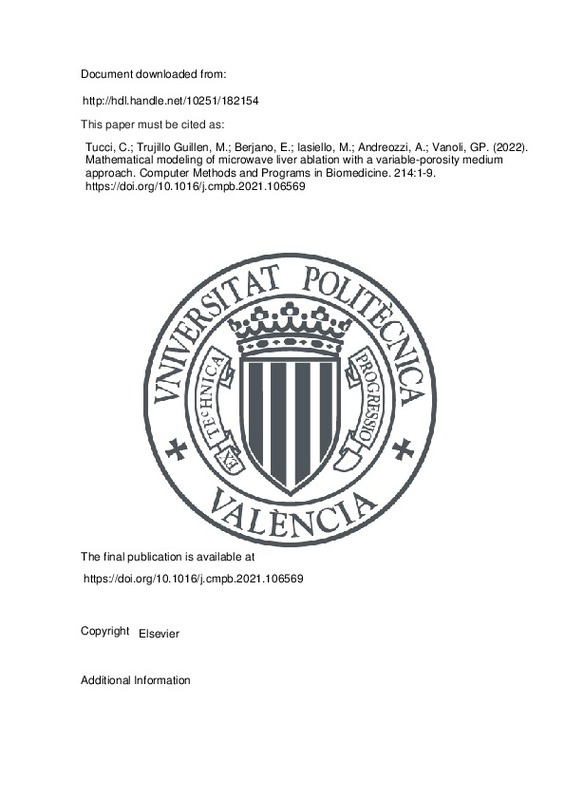JavaScript is disabled for your browser. Some features of this site may not work without it.
Buscar en RiuNet
Listar
Mi cuenta
Estadísticas
Ayuda RiuNet
Admin. UPV
Mathematical modeling of microwave liver ablation with a variable-porosity medium approach
Mostrar el registro sencillo del ítem
Ficheros en el ítem
| dc.contributor.author | Tucci, Claudio
|
es_ES |
| dc.contributor.author | Trujillo Guillen, Macarena
|
es_ES |
| dc.contributor.author | Berjano, Enrique
|
es_ES |
| dc.contributor.author | Iasiello, Marcello
|
es_ES |
| dc.contributor.author | Andreozzi, Assunta
|
es_ES |
| dc.contributor.author | Vanoli, Giuseppe Peter
|
es_ES |
| dc.date.accessioned | 2022-04-27T06:28:25Z | |
| dc.date.available | 2022-04-27T06:28:25Z | |
| dc.date.issued | 2022-02 | es_ES |
| dc.identifier.issn | 0169-2607 | es_ES |
| dc.identifier.uri | http://hdl.handle.net/10251/182154 | |
| dc.description.abstract | [EN] Background and objectives: Thermal ablation of tumors plays a key role to fight cancer, since it is a minimally invasive treatment which involves some advantages compared to surgery and chemotherapy, such as shorter hospital stays and consequently lower costs, along with minor side effects. In this context, computational modeling of heat transfer during thermal ablation is relevant to accurately predict the obtained ablation zone in order to avoid tumor recurrence risk caused by incomplete ablation, and the same time to save the surrounding healthy tissue. The aim of this work is to develop a more realistic porous media-based mathematical model to simulate a microwave thermal ablation (MWA) of an in vivo liver tumor surrounded by healthy tissue. Methods: The domain is made up of a spherical tumor bounded by a cylindrical healthy liver tissue. The simulated microwave antenna is a 14 G HS Amica-Gen Probe, and the supplied power of 60 W is applied for 300 s and 600 s. The model consists in coupling modified Local Thermal Non Equilibrium (LTNE) equations with the electromagnetic equations. The LTNE equations include a variable porosity function which fits the porosity changing from the tumor core to the rim based on experimental measures in in vivo cases. Moreover, four different blood vessels' uniform distributions are investigated to compare the effects of different vascularizations of the considered target tissue. Results: The results are shown in terms of temperature fields, ablation diameters and volumes based on the Arrhenius thermal damage model with 99% of cell death probability. The outcomes show a very good agreement with a clinical study on human patients with hepatocellular carcinoma using the same antenna and energy setting, when terminal arteries distribution is included. Conclusions: In this work, an in vivo microwave ablation of liver tumor surrounded by healthy tissue is modeled with a variable-porosity medium approach based on experimental measures. The outcomes shown for distinct vascularizations underline the key relevance of modeling more and more accurately tumor MWA, by considering increasingly realistic features, avoiding tumor recurrence, and improving both medical protocols and devices. (C) 2021 Elsevier B.V. All rights reserved. | es_ES |
| dc.description.sponsorship | This work was supported by the Grant RTI2018-094357-B-C21 funded by MCIN/AEI/10.13039/501100 011033 and by the Italian Government MIUR Grant No. "PRIN-2017F7KZWS". This work was also supported by the Universitadegli Studi di Napoli Federico II international mobility program for researchers | es_ES |
| dc.language | Inglés | es_ES |
| dc.publisher | Elsevier | es_ES |
| dc.relation.ispartof | Computer Methods and Programs in Biomedicine | es_ES |
| dc.rights | Reconocimiento - No comercial - Sin obra derivada (by-nc-nd) | es_ES |
| dc.subject | Bioheat equation | es_ES |
| dc.subject | Numerical modeling | es_ES |
| dc.subject | Microwave ablation | es_ES |
| dc.subject | Porous media model | es_ES |
| dc.subject | Variable porosity | es_ES |
| dc.subject.classification | TECNOLOGIA ELECTRONICA | es_ES |
| dc.subject.classification | MATEMATICA APLICADA | es_ES |
| dc.title | Mathematical modeling of microwave liver ablation with a variable-porosity medium approach | es_ES |
| dc.type | Artículo | es_ES |
| dc.identifier.doi | 10.1016/j.cmpb.2021.106569 | es_ES |
| dc.relation.projectID | info:eu-repo/grantAgreement/AEI/Plan Estatal de Investigación Científica y Técnica y de Innovación 2017-2020/RTI2018-094357-B-C21/ES/MODELADO Y EXPERIMENTACION PARA TERAPIAS ABLATIVAS INNOVADORAS/ | es_ES |
| dc.relation.projectID | info:eu-repo/grantAgreement/MIUR//PRIN-2017F7KZWS/ | es_ES |
| dc.rights.accessRights | Abierto | es_ES |
| dc.contributor.affiliation | Universitat Politècnica de València. Departamento de Ingeniería Electrónica - Departament d'Enginyeria Electrònica | es_ES |
| dc.contributor.affiliation | Universitat Politècnica de València. Departamento de Matemática Aplicada - Departament de Matemàtica Aplicada | es_ES |
| dc.description.bibliographicCitation | Tucci, C.; Trujillo Guillen, M.; Berjano, E.; Iasiello, M.; Andreozzi, A.; Vanoli, GP. (2022). Mathematical modeling of microwave liver ablation with a variable-porosity medium approach. Computer Methods and Programs in Biomedicine. 214:1-9. https://doi.org/10.1016/j.cmpb.2021.106569 | es_ES |
| dc.description.accrualMethod | S | es_ES |
| dc.relation.publisherversion | https://doi.org/10.1016/j.cmpb.2021.106569 | es_ES |
| dc.description.upvformatpinicio | 1 | es_ES |
| dc.description.upvformatpfin | 9 | es_ES |
| dc.type.version | info:eu-repo/semantics/publishedVersion | es_ES |
| dc.description.volume | 214 | es_ES |
| dc.identifier.pmid | 34906785 | es_ES |
| dc.relation.pasarela | S\451781 | es_ES |
| dc.contributor.funder | AGENCIA ESTATAL DE INVESTIGACION | es_ES |
| dc.contributor.funder | Ministero dell'Istruzione dell'Università e della Ricerca | es_ES |







![[Cerrado]](/themes/UPV/images/candado.png)

